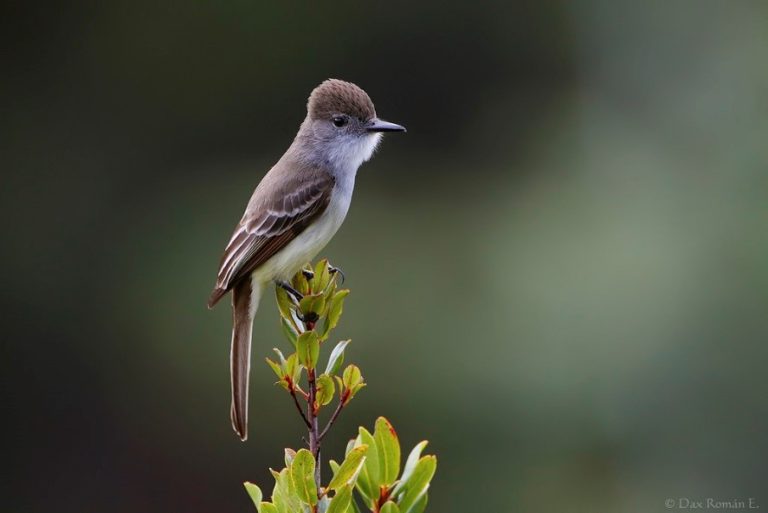Birdfinding.info ⇒ On Jamaica, common and conspicuous at the driest sites: Portland Ridge, the Hellshire Hills, and Treasure Beach. Can also be found at Rocklands Bird Sanctuary, Robin’s Bay, and some parts of Cockpit Country: e.g., Stewart Town. In the Dominican Republic, common below La Placa and along the shores of Lago Enriquillo. Also common in the eastern tourist corridor: e.g., Punta Cana, La Romana, and Del Este National Park.
Stolid Flycatcher
Myiarchus stolidus
Family: Tyrannidae
Endemic to Jamaica, Hispaniola, and its satellite islands (Gonâve, Tortue, Beata, Grand Cayemite, and Saona), where it occupies various wooded and semiopen habitats, from mangroves and scrub to montane pine forests.
Most numerous in dry scrub zones, as along the southern coast of Jamaica, where it is a predominant member of the avifauna. Occurs locally in humid woodlands, mostly at low elevations.
Identification
A mid-sized Myiarchus with an ashy-gray throat, pale yellow belly, cold brown upperparts, three well-defined whitish wingbars, bold whitish margins on the tertials, and narrow rufous edging on the primaries.
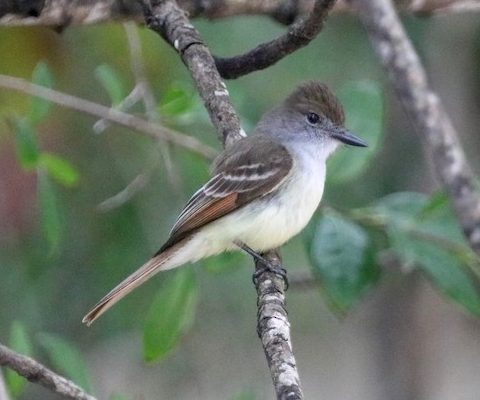
Stolid Flycatcher, M. s. dominicensis, showing rufous margins on primaries. (Labadie, Haiti; March 16, 2018.) © Graham Williams
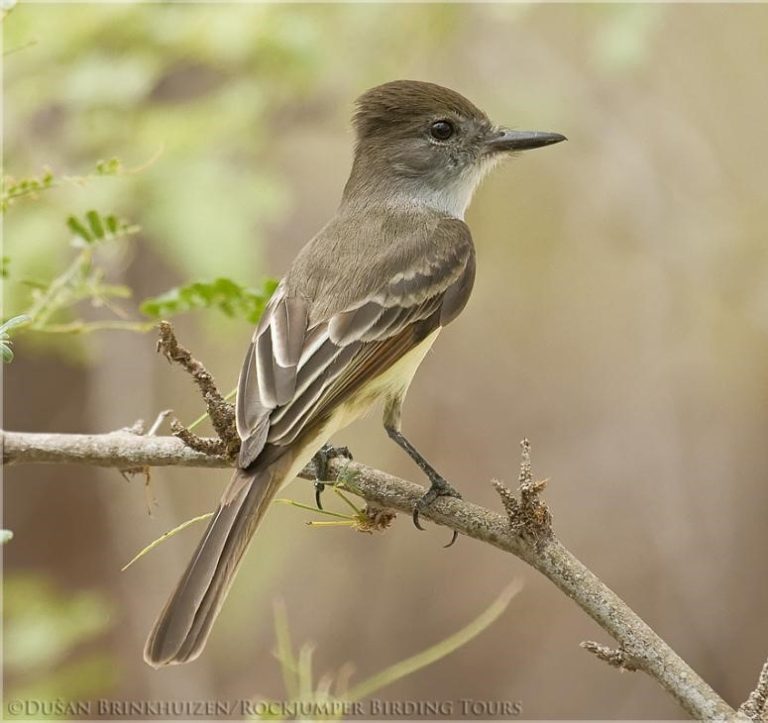
Stolid Flycatcher, M. s. dominicensis, with atypically muted contrasts on the wings. (Cabo Rojo, Dominican Republic; February 18, 2016.) © Duŝan M. Brinkhuizen

Stolid Flycatcher, M. s. dominicensis, showing warmer tones than most. (Ébano Verde Scientific Reserve, Dominican Republic; May 16, 2015.) © Dax M. Román E.
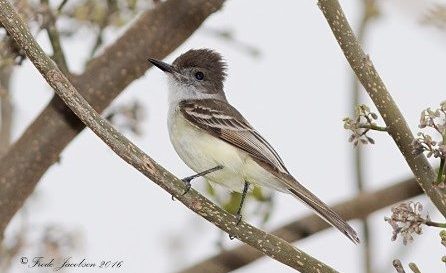
Stolid Flycatcher, M. s. stolidus, with unusually faint yellow wash on the belly. (Jamaica; April 2016.) © Frode Jacobsen
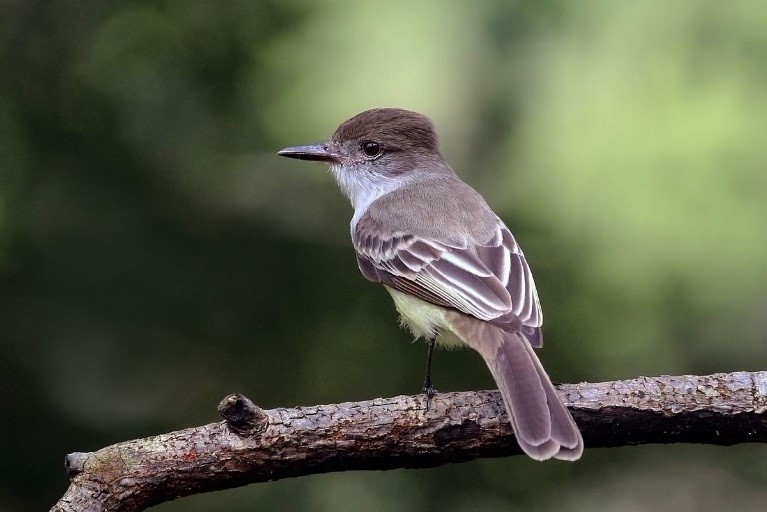
Stolid Flycatcher, M. s. stolidus, showing characteristically bold contrasting highlights on the wings. (Stewart Town, Jamaica; February 13, 2016.) © Charles J. Sharp
The inner webs of the tail feathers (except the two central retrices) are bright rufous—this coloration is always visible on the undertail. The upperside of the tail is dark brown when folded, but flashes rufous when the tail is spread, revealing the inner webs.
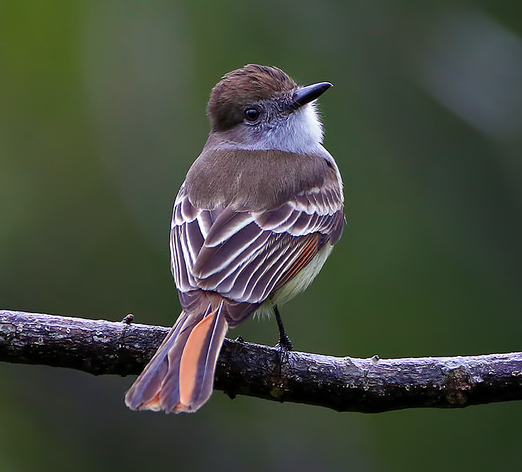
Stolid Flycatcher, M. s. dominicensis, with outer tail feather fully exposed, revealing rufous inner web—also note the boldly contrasting highlights on the wings. (Ébano Verde Scientific Reserve, Dominican Republic; May 15, 2014.) © Dax M. Román E.

Stolid Flycatcher, M. s. dominicensis, showing rufous undertail. (Laguna Azuei, Jimani, Dominican Republic; February 4, 2014.) © Carlos de Soto Molinari
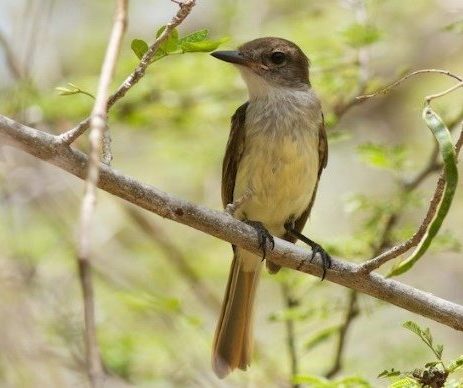
Stolid Flycatcher, M. s. stolidus. (Portland Cottage, Jamaica; July 27, 2015.) © Jeff Gerbracht
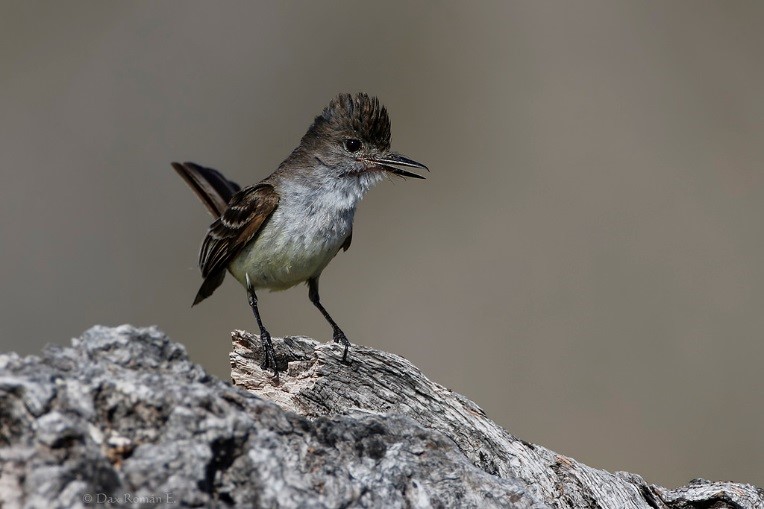
Stolid Flycatcher, M. s. dominicensis, in alarm posture while investigating the photographe. (Salinas Peravia, Dominican Republic; June 18, 2016.) © Dax M. Román E.

Stolid Flycatcher, M. s. dominicensis, with atypically bright yellow belly. (Salinas Peravia, Dominican Republic; February 10, 2018.) © Francisco Alba Suriel
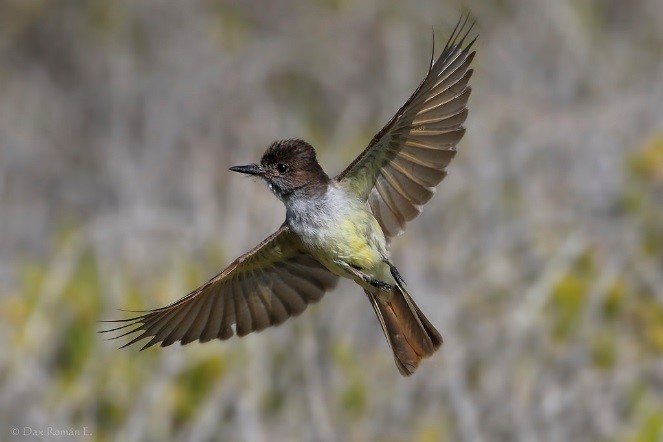
Stolid Flycatcher, M. s. dominicensis. (Salinas Peravia, Dominican Republic; June 18, 2016.) © Dax M. Román E.
Cf. Other Myiarchus Flycatchers. On Jamaica, Stolid occurs alongside two other Myiarchus species, Sad and Rufous-tailed Flycatchers. Stolid is intermediate in size, lacks the extensively rusty plumage of the larger Rufous-tailed, and has whiter wing markings and less extensively yellow underparts than the smaller Sad Flycatcher.
Great Crested Flycatcher has occurred as a vagrant in Stolid’s range. It is much warmer and rustier overall, with less contrast in its wings and a brighter yellow belly.
Notes
Polytypic species consisting of two recognized subspecies: sagrae of Cuba, the Isle of Youth, Grand Cayman, and Great Inagua; and lucaysiensis of the northern Bahamas.
Formerly considered conspecific with Stolid, Puerto Rican, and Lesser Antillean Flycatchers, collectively the Stolid Flycatcher, M. stolidus.
Frontiers of Taxonomy: Divergence and Convergence in the Stolid-La-Sagra’s Flycatcher Complex.
The taxonomic status and relationships of the four subspecies currently grouped under Stolid and La Sagra’s Flycatchers present a conundrum. When Lanyon analyzed their measurements, coloration, vocalizations, response to tape playback, he found that the Jamaican stolidus and Hispaniolan dominicensis were nearly identical, and that the Cuban sagrae and Bahamian lucaysiensis were only slightly more distinguishable from one another. This was the original basis for recognizing La Sagra’s Flycatcher as a separate species.
However, Joseph et al.’s 2004 study of mitochondrial DNA reached a potentially conflicting result. In essence, they found that the Jamaican stolidus (Stolid) and Cuban sagrae (La Sagra’s) are more closely related to one another by ancestry than either is to dominicensis or lucaysiensis. Conversely, they found that the Hispaniolan dominicensis (Stolid) and Bahamian lucaysiensis (La Sagra’s) are also one another’s closest ancestral relatives.
Assuming that the genetic evidence is accurate (i.e., not somehow a fluke of the individuals sampled or the analytical methods used), this situation seems to suggest some form of coevolution. In simplified terms, it suggests that a split occurred between two lineages (representing sagrae/stolidus and lucaysiensis/dominicensis), and that later each of these lineages diverged internally, but somehow each of the resulting four lineages “converged” with a less-related lineage—assembling the current Stolid and La Sagra’s Flycatcher species.
Although this hypothesis may seem peculiar, there may be a biogeographical mechanism that would enable it. Lucaysiensis is found on smaller islands than the others, and is prone to wandering (e.g., regularly straying to southern Florida), while the other three subspecies appear to be mostly sedentary. Perhaps, then, regular strays of lucaysiensis into the range of sagrae resulted in new gene flow between these forms, introducing traits of lucaysiensis into sagrae. This would allow these subspecies to share features, rapidly spread through sexual selection, while the underlying drift in mitochrondrial DNA in the respective populations proceeded on its gradual, inexorable pace.
The argument for continuing to recognize Stolid and La Sagra’s Flycatchers as currently configured is that, as far as has been documented, stolidus and dominicensis are essentially indistinguishable in the field, as are sagrae and lucaysiensis. Functionally, these appear to be the two species definitions that the birds themselves would likely recognize, so the current taxonomic consensus makes sense, even if it contradicts the underlying phylogenetic relationships.
References
eBird. 2019. eBird: An online database of bird distribution and abundance. Cornell Lab of Ornithology, Ithaca, N.Y. http://www.ebird.org. (Accessed February 7, 2019.)
Haynes-Sutton, A., A. Downer, R. Sutton, and Y.-J. Rey-Millet. 2009. A Photographic Guide to the Birds of Jamaica. Princeton University Press, Princeton, N.J.
Joseph, L., T. Wilke, E. Bermingham, D. Alpers, and R. Ricklefs. 2004. Towards a phylogenetic framework for the evolution of shakes, rattles, and rolls in Myiarchus tyrant-flycatchers (Aves: Passeriformes: Tyrannidae). Molecular Phylogenetics and Evolution 31:139-152.
Lanyon, W.E. 1967. Revision and probable evolution of the Myiarchus flycatchers of the West Indies. Bulletin of the American Museum of Natural History 136:329-370.
Latta, S., C. Rimmer, A. Keith, J. Wiley, H. Raffaele, K. McFarland, and E. Fernandez. 2006. Birds of the Dominican Republic and Haiti. Princeton University Press, Princeton, N.J.
Raffaele, H., J. Wiley, O. Garrido, A. Keith, and J. Raffaele. 1998. A Guide to the Birds of the West Indies. Princeton University Press, Princeton, N.J.
